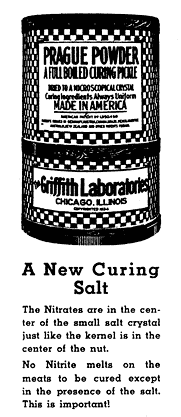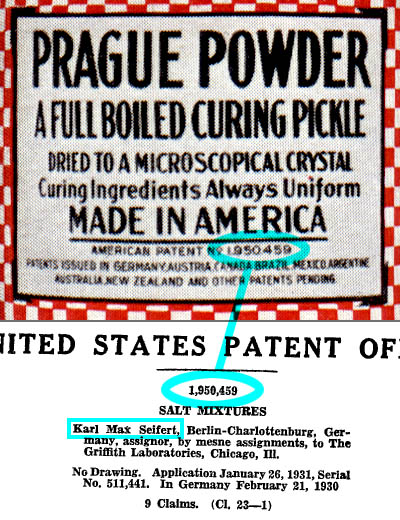Lloyd Augustus Hall - myths
A prominent figure in the pantheon of black inventor-heroes is industrial chemist Lloyd Hall, who worked for some time as the chief chemist for Griffith Laboratories, a company specializing in food processing products and food additives. A few writers, evidently unsatisfied with Hall's real contributions, have reshaped them into world-changing triumphs — absurd exaggerations that plainly conflict with the history of food science. Hattie Carwell hyperbolizes in her book Blacks in Science:1
[Lloyd Hall] is responsible for the meat curing products, seasonings, emulsions, bakery products, antioxidants, protein hydrolysates, and many other products that keep our food fresh and flavorable.
The above is somewhat like saying "Joe Schmo is responsible for the cars, trucks, buses, trains, planes, boats, and many other vehicles that keep us moving and on schedule." Astonishingly, verbatim chunks of Carwell's tall tale found their way onto websites hosted by Princeton University, About.com, and other organizations whose website editors really should know better. A bit of fact-checking would have revealed that seasonings and meat curing salts are ancient, that Julius Maggi popularized protein hydrolysates as flavor enhancers in 1886, and that lecithin, first isolated in 1846, was used both as an emulsifier and an antioxidant before Lloyd Hall had any patents in food chemistry.2 No one scientist could have introduced more than a minuscule fraction of the myriad food additives in use today.

from National Provisioner, 4 May 1935
"Revolutionized the meatpacking industry"?
The most hyped invention attributed to Hall is a meat-curing salt (for preserving meat and reddening its color) that "revolutionized the meatpacking industry," as About.com and several other sites would have us believe. Louis Haber in Black Pioneers of Science and Invention brags that it was "far superior to any meat-curing salts ever produced."3 None of the various biographical blurbs — which apparently derive from the same few sources — divulge the name of this mystery miracle product, which can only be "Prague Powder," the curing composition marketed by Hall's employer, Griffith Laboratories, from 1934 onward. Prague Powder was Griffith's signature product: it was heavily advertised in the meatpacking journal National Provisioner, and a water tower painted like a giant can of the stuff stood prominently atop the company's main factory in Chicago.4 Composed of microscopic nitrate/nitrite salts encased inside tiny grains of sodium chloride, the powder perfectly fits descriptions of the anonymous curing salt that Hall supposedly "invented" while at Griffith.5
But looking at the patent number shown on the earliest advertisements and checkered containers, we see that the product was originated not by Lloyd Hall, but by a German, Karl Max Seifert!

Top: label of Prague Powder drum (cover of National Provisioner, 26 Jan 1935). Bottom: part of Seifert's patent.
Indeed, the powdery salt mixture described in Seifert's patent matches characteristics that have erroneously been credited to Hall:
- It was manufactured by rapidly drying a salt solution on heated metal rollers ("flash drying" process).
- Each grain or particle contained one or more secondary salts within a main salt, sodium chloride.
After Seifert's patent was assigned to Griffith Laboratories, the company's head honcho Enoch L. Griffith adapted the invention specifically for meat curing, using alkali metal nitrates and nitrites, well-known curing agents, as the secondary salts to be fused with the common salt. He admitted that the process for creating the powder was a "development under the Seifert patent No. 1,950,459."6 The presence of all curing ingredients in each particle ensured that the ingredients were uniformly distributed throughout the mix, and that the nitrate/nitrite would always be accompanied by sodium chloride when penetrating the meat. The powder replaced "Prague Salt," an earlier nitrite cure that Griffith Labs had been importing from Germany since 1925.
While the essential ingredients and structure of Prague Powder remained the same, Lloyd Hall obtained at least seven patents concerned with either reducing the powder's tendency to cake, or preventing unwanted side effects of the anti-caking agents. In the patent documents, Hall never claimed to have originated the curing powder or the "flash-drying" process for making it, and multiple times referred to the earlier Enoch Griffith patents #2,054,624 and #2,054,626 — themselves extensions of the Seifert patent. Although Hall helped delay the onset of caking from under two weeks in the 1930s to a few months by the mid-1950s,7 patent applications by Louis Sair and other Griffith workers in the 1960s reported that the caking problem was still not satisfactorily solved. Sair and others tackled the problem for good by physically altering the salt particles in such a way that they could not clump together.8
To the extent that Lloyd Hall's refinement of Griffith Labs' curing composition represented an advance, it was incremental — far from a true breakthrough that could have "revolutionized the meatpacking industry." Even after the refinements, the active ingredients of Prague Powder were still the same old nitrite and/or nitrate salts flash-fused with sodium chloride. How did all the credit get shifted to Lloyd Hall? Perhaps those who wanted to advertise Hall's achievements overzealously assumed that the chemist, in his high-level position at Griffith, singlehandedly "invented" whatever the company made. In any case, there's little chance the myths will go away anytime soon, as they are carelessly repeated even on reputable websites.
References/Notes
- H. Carwell, Blacks in Science: Astrophysicist to Zoologist (Hicksville, N.Y.: Exposition Press, 1977), 27.
- In 1926 Hermann Bollmann pointed out that adding lecithin to refined oils prevents oxidation and thus retards rancidity (US Patent 1,575,529). Soy lecithin was used as an emulsifier in margarine as early as 1925 by manufacturers in Hamburg, Germany (Shurtleff and Aoyagi, "History of Soy Lecithin," http://www.thesoydailyclub.com/SFC/MSPproducts531.asp [accessed 22 Oct 2004]). Lloyd Hall received no food-related patents until 1933 ("Protective Coating," US Patent 1,914,351).
- Louis Haber, Black Pioneers of Science and Invention (San Diego: Harcourt Brace Jovanovich, 1987, c1970), p.151.
- "The Significant Sixty": A Historical Report on the Progress and Development of the Meat Packing Industry, 1890-1951. Section Two, National Provisioner, January 24, 1952, p. 231
- Haber, describing the anonymous curing salt, refers to "the ingenious method of enclosing the nitrate and nitrite inside the sodium chloride crystal." (p. 151)
- E.L. Griffith, US patents 2,054,623 through 2,054,626.
- L. Hall and C. Griffith, US patent 2,770,550
- L. Sair, US patent 3,508,931. Sair says that the caking problem was "resolved by inventions of U.S. Patent 3,164,480 [Sair, Reschke], U.S. Reissue Patent 25,996 [Sair, C. Griffith], and U.S. application Ser. No. 576,862, filed Sept. 2, 1966, issued as U.S. Patent 3,335,016 [Sair, C. Griffith]."